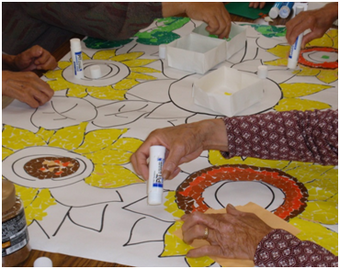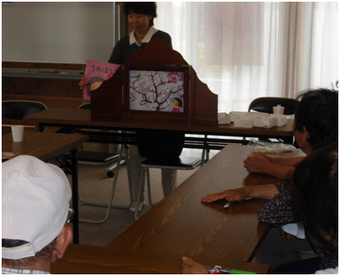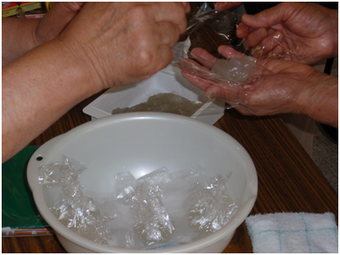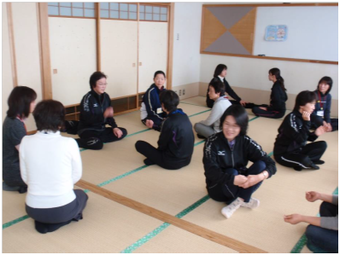East Japan Great Earthquake: Fukushima Sou-Sou District Medical Project Report 13
Hereunder is the 2nd report by Yayoi Yokouchi, Clinical Psychotherapist.
———————————
Photos: as seen from the above

1. Working with Chigiri-e (June-July 2015)

2. Picture-card Show (Stage Boards donated by MDMJ)

3. Making Warabi-Mochi (Rice-cake)

4. Thank-You Party for aid workers, December 2014,
at Healthcare Center
1.Community Meeting at Happouuchi Provisional Housing Complex(residents of Namie) (Every 2nd and 4th Thursdays at 10:00~11:30 a.m)
Program
①Blood-pressure measurement, Health checkup
②Qigong exercise
③Activity
④Tea party
① While measuring blood pressure, a simple question like “how are you?” develops conversation to a wider range of topics such as changes in recent health conditions, sleeping difficulty, etc….
② Qigong is easy to learn, gentle and slow, anyone can do it, even those in wheelchairs or those who lost limb function. Everyone together in a circle, just follow the flowing movements of your instructor, and you will feel inner peace and a sense of oneness with other people and with the whole world.
③ Activity: Workshop to experience performing a picture-card show. Focus on the use of hands and brain to vitalize them through creation of room ornaments or through cooking seasonal sweets. I myself join the activities, sometimes as a workshop facilitator, sometimes as a program planner, and I really enjoy the time spent with the participants. At present, we are challenging Chigiri-e (collage of pieces of colored paper) to create an image of sun-flowers pasting different colors of paper on an A1-size paper. Chigiri-e, one of traditional art forms, takes time and patience but is worth challenging. My hope is that these activities help motivate everyone to live more healthily and actively. I am deeply touched by all those community people helping and caring one another, and fostering a lasting relationship between each other.
2.Home-visiting Service (Outreach Activity)
Once a month, or every six months, the home-visit frequency is variable according to the urgency of each case. In principle, the home-visit is accompanied by Nagomi’s specialist and a Healthcare Center personnel, and is intended for: school children with developmental disability or children unwilling or refusing to go to school; the mentally disabled; bereaved families of the Tsunami victims; alcohol dependents or near alcoholics; elderly people with signs of depression or with multiple symptoms combined, etc. Repeating visits only a few times proves to be effective in creating intimate atmosphere between two parties, and makes it possible for both listeners and speakers to exchange communication in relaxed and friendly manners. Thus after and through our visits, they open their heart little by little and tell us about their painful loss and sorrows hidden deep in their souls, and with a slight hesitation, begin talking about their agonizing stories on how and why they have isolated themselves from the rest of the world. All we can do is to stay close to them, listen to them, and say a few words, “You are never alone, you matter so much to us,” or just “How are you today?” In case of children, just to sit near them, and show them how much we are concerned over their problems is very likely to have an effective therapeutic potential. I felt very happy when a junior-high student A, who had been truant since his 1st grade, successfully passed the exam for high school correspondence course.
For a woman in her eighties who is a tsunami survivor, our visit seems to be a pleasant opportunity to speak to us in every detail of what she knows about life in Showa Era including how she lived the same era. While talking, she looks truly alive. Deeply moved and inspired by her talks, I have questioned quite a few times not only about her past but also about her hometown Minami Soma, its regional character and culture. If deprived of your family life built up over more than half a century, or if your secure old age with children and grandchildren suddenly destroyed, you still have to live on. I strongly hope that these people continue living healthily and fulfill their life with a purpose.
3.Meetings and Events organized by administrative bodies, healthcare centers and other public sectors
NAGOMI has been approached as to the participation in the ongoing meetings and events. As I have been working as a volunteer at this timing, I am ready and willing to participate in them with Nagomi’s member. It will be a good opportunity for me to learn and become familiar with local circumstances. Besides, it is possible for me to state my opinion from a psychological point of view based on my knowledge about Child Development.
During a routine health checkup (for children of 1.5-year old and 3-year old), I am sometimes asked to give counsel to mothers, as an assistant to the community nurse who is in charge of health examination. Despite my status within a capacity of backup position, I always do my best, listening to them carefully what they are worried about, children’s developmental problems, the impact on children of post-quake environment or of radioactive contamination, and more. Face to face with the grieving mothers, I feel their grief and anxiety as my own.
*A greater part of this mental healthcare activity is funded by the “Live-Together- Fund” of Japan Platform.
